Human Resource Management: Recruitment and Selection Essay
VerifiedAdded on 2020/05/11
|9
|2135
|121
Essay
AI Summary
This essay delves into the critical role of recruitment and selection in human resource management (HRM), emphasizing their impact on attracting and retaining employees. It explores the two primary types of recruitment: internal and external, highlighting the advantages of each. Internal recruitment fosters employee retention, while external recruitment broadens the talent pool. The essay then examines selection procedures, stressing the importance of fair practices, unbiased evaluations, and clear communication. It discusses how a well-structured selection process, including application reviews, interviews, and health assessments, contributes to employee motivation and retention. The study concludes by underscoring the influence of effective recruitment and selection strategies on organizational success, including attracting skilled candidates, fostering employee engagement, and minimizing turnover. The essay emphasizes that organizations should focus on ethical practices and transparent policies to attract and retain the best employees.
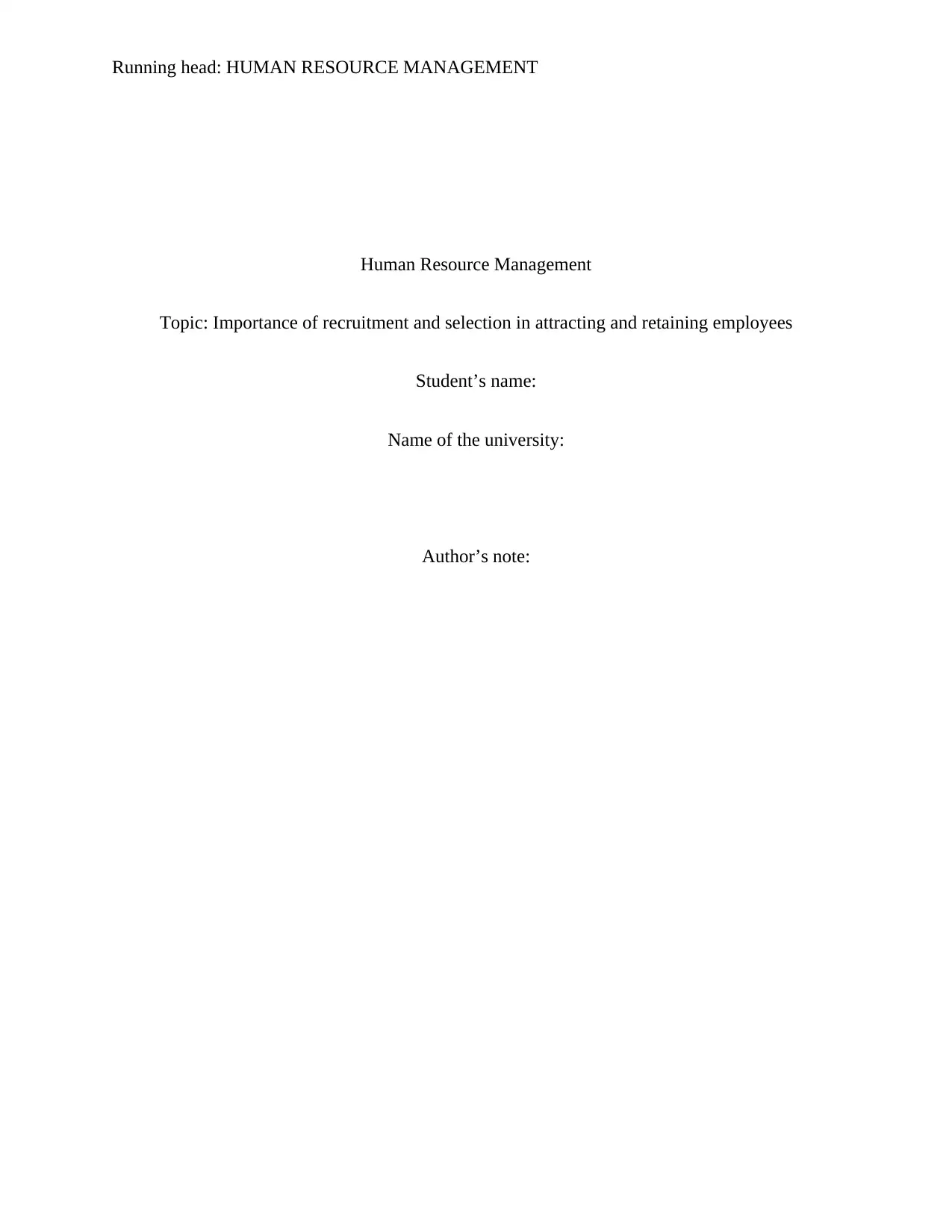
Running head: HUMAN RESOURCE MANAGEMENT
Human Resource Management
Topic: Importance of recruitment and selection in attracting and retaining employees
Student’s name:
Name of the university:
Author’s note:
Human Resource Management
Topic: Importance of recruitment and selection in attracting and retaining employees
Student’s name:
Name of the university:
Author’s note:
Paraphrase This Document
Need a fresh take? Get an instant paraphrase of this document with our AI Paraphraser
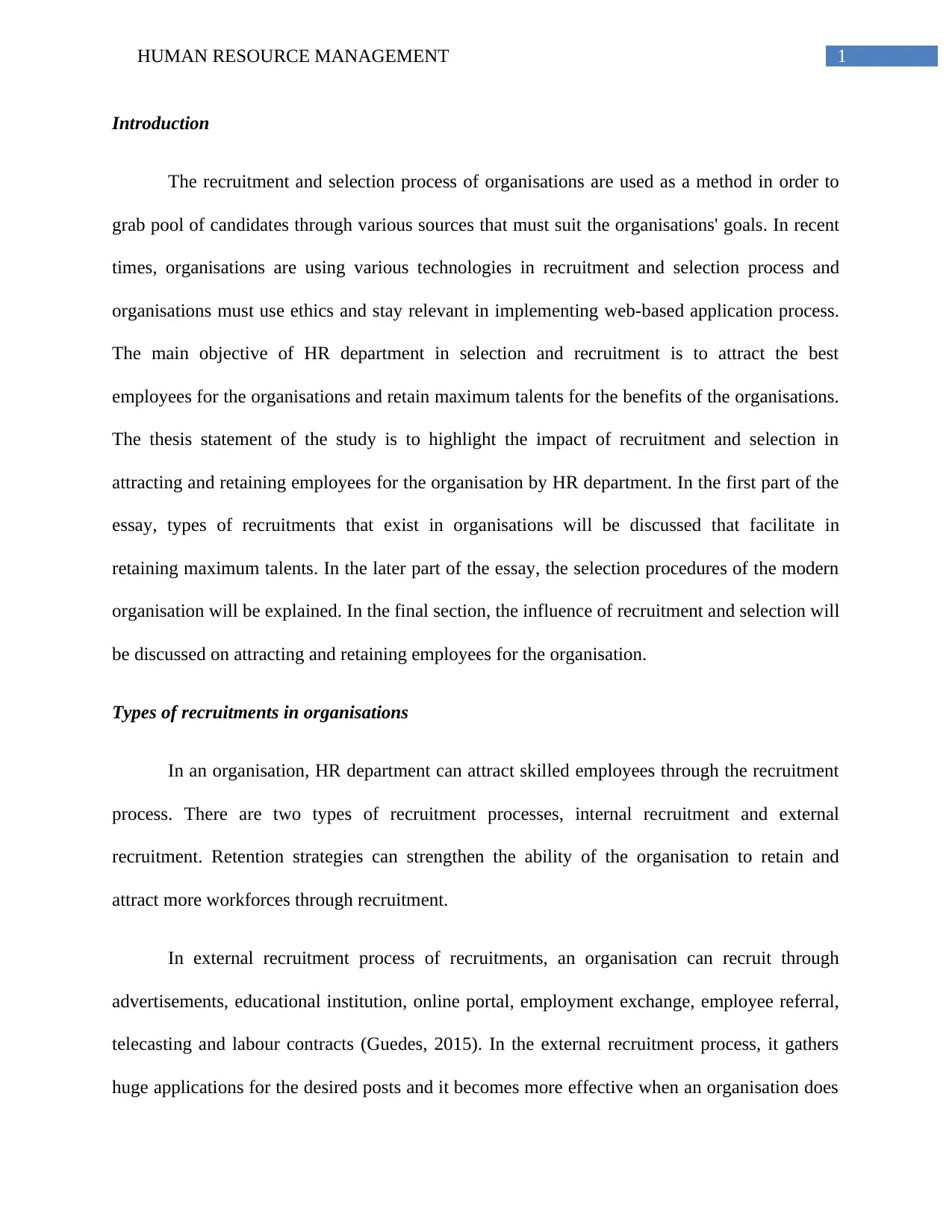
1HUMAN RESOURCE MANAGEMENT
Introduction
The recruitment and selection process of organisations are used as a method in order to
grab pool of candidates through various sources that must suit the organisations' goals. In recent
times, organisations are using various technologies in recruitment and selection process and
organisations must use ethics and stay relevant in implementing web-based application process.
The main objective of HR department in selection and recruitment is to attract the best
employees for the organisations and retain maximum talents for the benefits of the organisations.
The thesis statement of the study is to highlight the impact of recruitment and selection in
attracting and retaining employees for the organisation by HR department. In the first part of the
essay, types of recruitments that exist in organisations will be discussed that facilitate in
retaining maximum talents. In the later part of the essay, the selection procedures of the modern
organisation will be explained. In the final section, the influence of recruitment and selection will
be discussed on attracting and retaining employees for the organisation.
Types of recruitments in organisations
In an organisation, HR department can attract skilled employees through the recruitment
process. There are two types of recruitment processes, internal recruitment and external
recruitment. Retention strategies can strengthen the ability of the organisation to retain and
attract more workforces through recruitment.
In external recruitment process of recruitments, an organisation can recruit through
advertisements, educational institution, online portal, employment exchange, employee referral,
telecasting and labour contracts (Guedes, 2015). In the external recruitment process, it gathers
huge applications for the desired posts and it becomes more effective when an organisation does
Introduction
The recruitment and selection process of organisations are used as a method in order to
grab pool of candidates through various sources that must suit the organisations' goals. In recent
times, organisations are using various technologies in recruitment and selection process and
organisations must use ethics and stay relevant in implementing web-based application process.
The main objective of HR department in selection and recruitment is to attract the best
employees for the organisations and retain maximum talents for the benefits of the organisations.
The thesis statement of the study is to highlight the impact of recruitment and selection in
attracting and retaining employees for the organisation by HR department. In the first part of the
essay, types of recruitments that exist in organisations will be discussed that facilitate in
retaining maximum talents. In the later part of the essay, the selection procedures of the modern
organisation will be explained. In the final section, the influence of recruitment and selection will
be discussed on attracting and retaining employees for the organisation.
Types of recruitments in organisations
In an organisation, HR department can attract skilled employees through the recruitment
process. There are two types of recruitment processes, internal recruitment and external
recruitment. Retention strategies can strengthen the ability of the organisation to retain and
attract more workforces through recruitment.
In external recruitment process of recruitments, an organisation can recruit through
advertisements, educational institution, online portal, employment exchange, employee referral,
telecasting and labour contracts (Guedes, 2015). In the external recruitment process, it gathers
huge applications for the desired posts and it becomes more effective when an organisation does
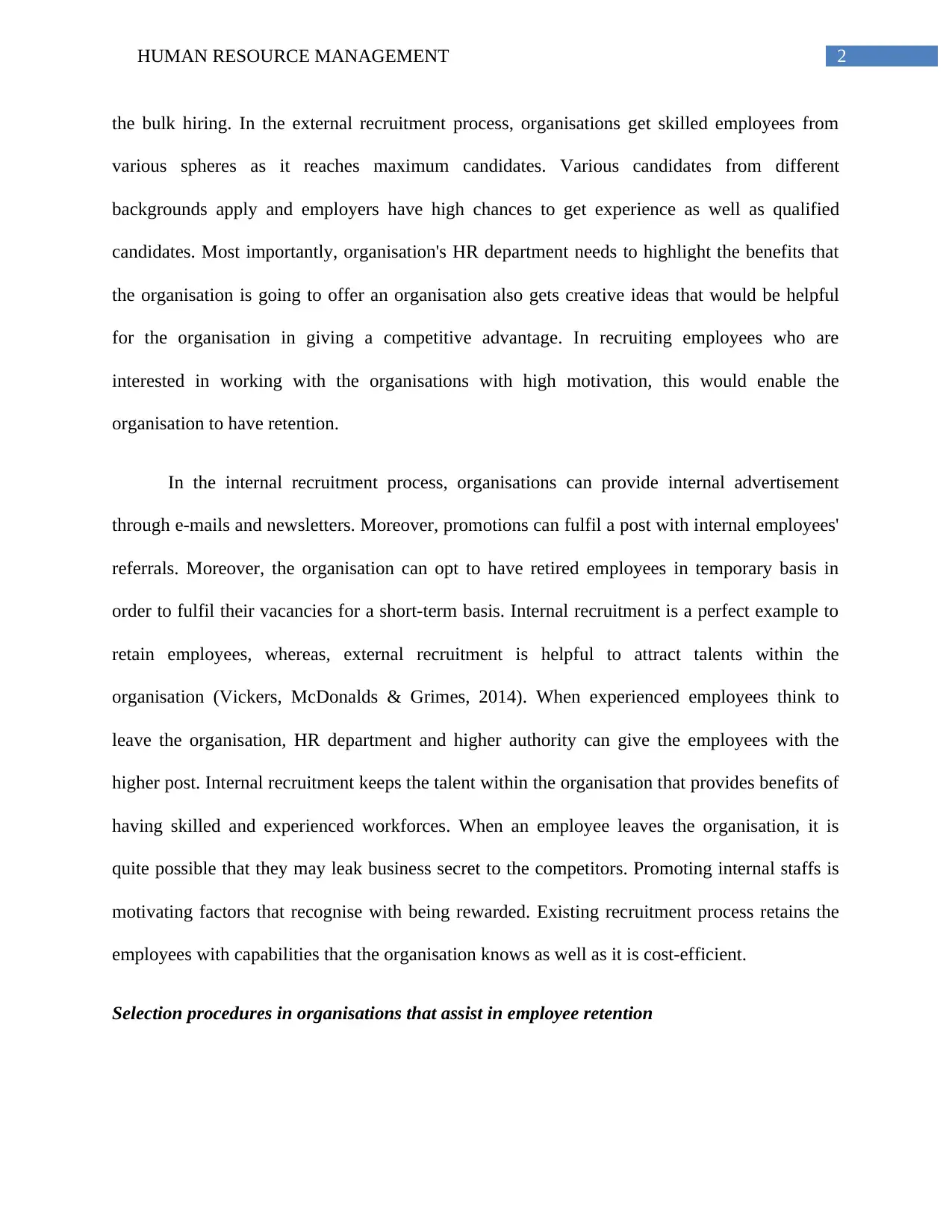
2HUMAN RESOURCE MANAGEMENT
the bulk hiring. In the external recruitment process, organisations get skilled employees from
various spheres as it reaches maximum candidates. Various candidates from different
backgrounds apply and employers have high chances to get experience as well as qualified
candidates. Most importantly, organisation's HR department needs to highlight the benefits that
the organisation is going to offer an organisation also gets creative ideas that would be helpful
for the organisation in giving a competitive advantage. In recruiting employees who are
interested in working with the organisations with high motivation, this would enable the
organisation to have retention.
In the internal recruitment process, organisations can provide internal advertisement
through e-mails and newsletters. Moreover, promotions can fulfil a post with internal employees'
referrals. Moreover, the organisation can opt to have retired employees in temporary basis in
order to fulfil their vacancies for a short-term basis. Internal recruitment is a perfect example to
retain employees, whereas, external recruitment is helpful to attract talents within the
organisation (Vickers, McDonalds & Grimes, 2014). When experienced employees think to
leave the organisation, HR department and higher authority can give the employees with the
higher post. Internal recruitment keeps the talent within the organisation that provides benefits of
having skilled and experienced workforces. When an employee leaves the organisation, it is
quite possible that they may leak business secret to the competitors. Promoting internal staffs is
motivating factors that recognise with being rewarded. Existing recruitment process retains the
employees with capabilities that the organisation knows as well as it is cost-efficient.
Selection procedures in organisations that assist in employee retention
the bulk hiring. In the external recruitment process, organisations get skilled employees from
various spheres as it reaches maximum candidates. Various candidates from different
backgrounds apply and employers have high chances to get experience as well as qualified
candidates. Most importantly, organisation's HR department needs to highlight the benefits that
the organisation is going to offer an organisation also gets creative ideas that would be helpful
for the organisation in giving a competitive advantage. In recruiting employees who are
interested in working with the organisations with high motivation, this would enable the
organisation to have retention.
In the internal recruitment process, organisations can provide internal advertisement
through e-mails and newsletters. Moreover, promotions can fulfil a post with internal employees'
referrals. Moreover, the organisation can opt to have retired employees in temporary basis in
order to fulfil their vacancies for a short-term basis. Internal recruitment is a perfect example to
retain employees, whereas, external recruitment is helpful to attract talents within the
organisation (Vickers, McDonalds & Grimes, 2014). When experienced employees think to
leave the organisation, HR department and higher authority can give the employees with the
higher post. Internal recruitment keeps the talent within the organisation that provides benefits of
having skilled and experienced workforces. When an employee leaves the organisation, it is
quite possible that they may leak business secret to the competitors. Promoting internal staffs is
motivating factors that recognise with being rewarded. Existing recruitment process retains the
employees with capabilities that the organisation knows as well as it is cost-efficient.
Selection procedures in organisations that assist in employee retention
⊘ This is a preview!⊘
Do you want full access?
Subscribe today to unlock all pages.

Trusted by 1+ million students worldwide
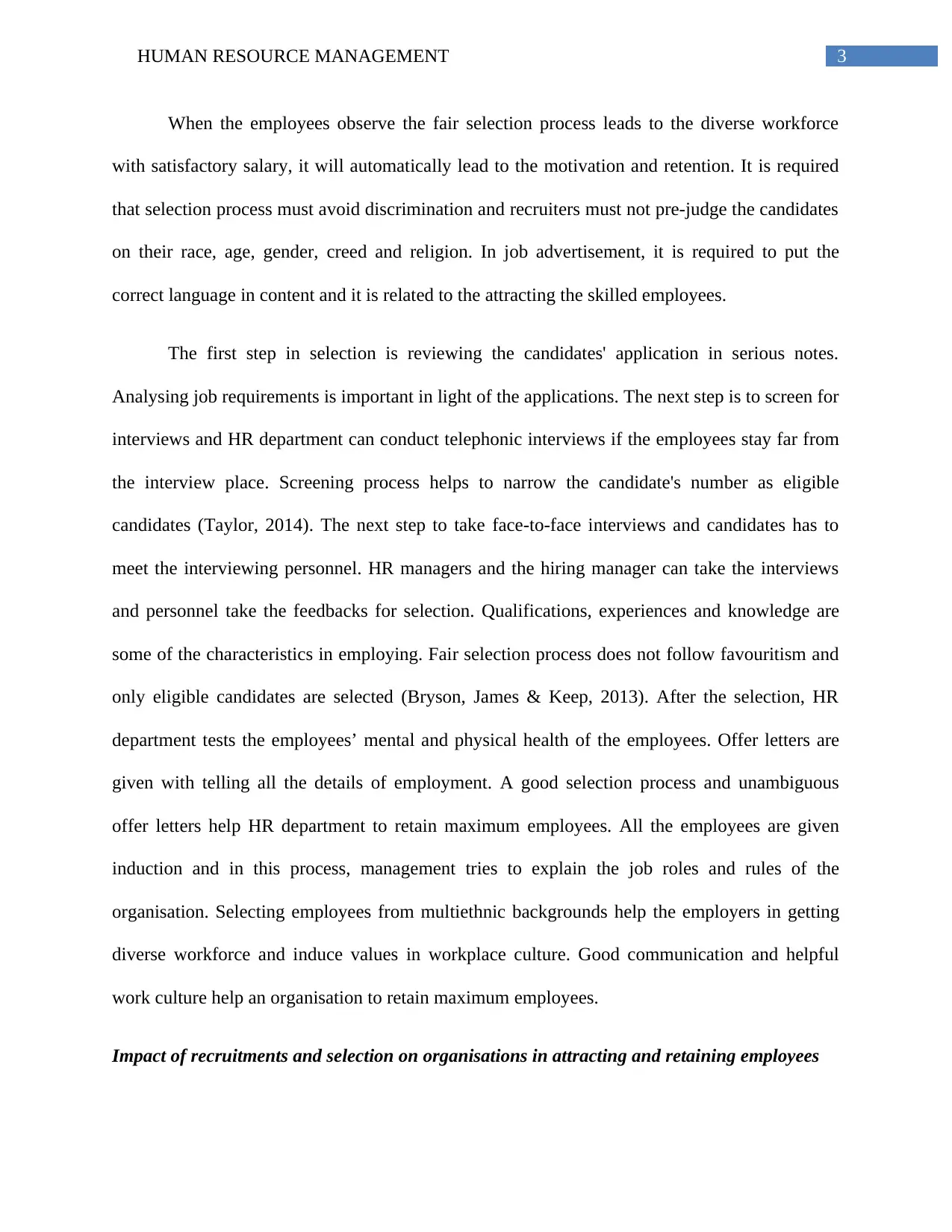
3HUMAN RESOURCE MANAGEMENT
When the employees observe the fair selection process leads to the diverse workforce
with satisfactory salary, it will automatically lead to the motivation and retention. It is required
that selection process must avoid discrimination and recruiters must not pre-judge the candidates
on their race, age, gender, creed and religion. In job advertisement, it is required to put the
correct language in content and it is related to the attracting the skilled employees.
The first step in selection is reviewing the candidates' application in serious notes.
Analysing job requirements is important in light of the applications. The next step is to screen for
interviews and HR department can conduct telephonic interviews if the employees stay far from
the interview place. Screening process helps to narrow the candidate's number as eligible
candidates (Taylor, 2014). The next step to take face-to-face interviews and candidates has to
meet the interviewing personnel. HR managers and the hiring manager can take the interviews
and personnel take the feedbacks for selection. Qualifications, experiences and knowledge are
some of the characteristics in employing. Fair selection process does not follow favouritism and
only eligible candidates are selected (Bryson, James & Keep, 2013). After the selection, HR
department tests the employees’ mental and physical health of the employees. Offer letters are
given with telling all the details of employment. A good selection process and unambiguous
offer letters help HR department to retain maximum employees. All the employees are given
induction and in this process, management tries to explain the job roles and rules of the
organisation. Selecting employees from multiethnic backgrounds help the employers in getting
diverse workforce and induce values in workplace culture. Good communication and helpful
work culture help an organisation to retain maximum employees.
Impact of recruitments and selection on organisations in attracting and retaining employees
When the employees observe the fair selection process leads to the diverse workforce
with satisfactory salary, it will automatically lead to the motivation and retention. It is required
that selection process must avoid discrimination and recruiters must not pre-judge the candidates
on their race, age, gender, creed and religion. In job advertisement, it is required to put the
correct language in content and it is related to the attracting the skilled employees.
The first step in selection is reviewing the candidates' application in serious notes.
Analysing job requirements is important in light of the applications. The next step is to screen for
interviews and HR department can conduct telephonic interviews if the employees stay far from
the interview place. Screening process helps to narrow the candidate's number as eligible
candidates (Taylor, 2014). The next step to take face-to-face interviews and candidates has to
meet the interviewing personnel. HR managers and the hiring manager can take the interviews
and personnel take the feedbacks for selection. Qualifications, experiences and knowledge are
some of the characteristics in employing. Fair selection process does not follow favouritism and
only eligible candidates are selected (Bryson, James & Keep, 2013). After the selection, HR
department tests the employees’ mental and physical health of the employees. Offer letters are
given with telling all the details of employment. A good selection process and unambiguous
offer letters help HR department to retain maximum employees. All the employees are given
induction and in this process, management tries to explain the job roles and rules of the
organisation. Selecting employees from multiethnic backgrounds help the employers in getting
diverse workforce and induce values in workplace culture. Good communication and helpful
work culture help an organisation to retain maximum employees.
Impact of recruitments and selection on organisations in attracting and retaining employees
Paraphrase This Document
Need a fresh take? Get an instant paraphrase of this document with our AI Paraphraser
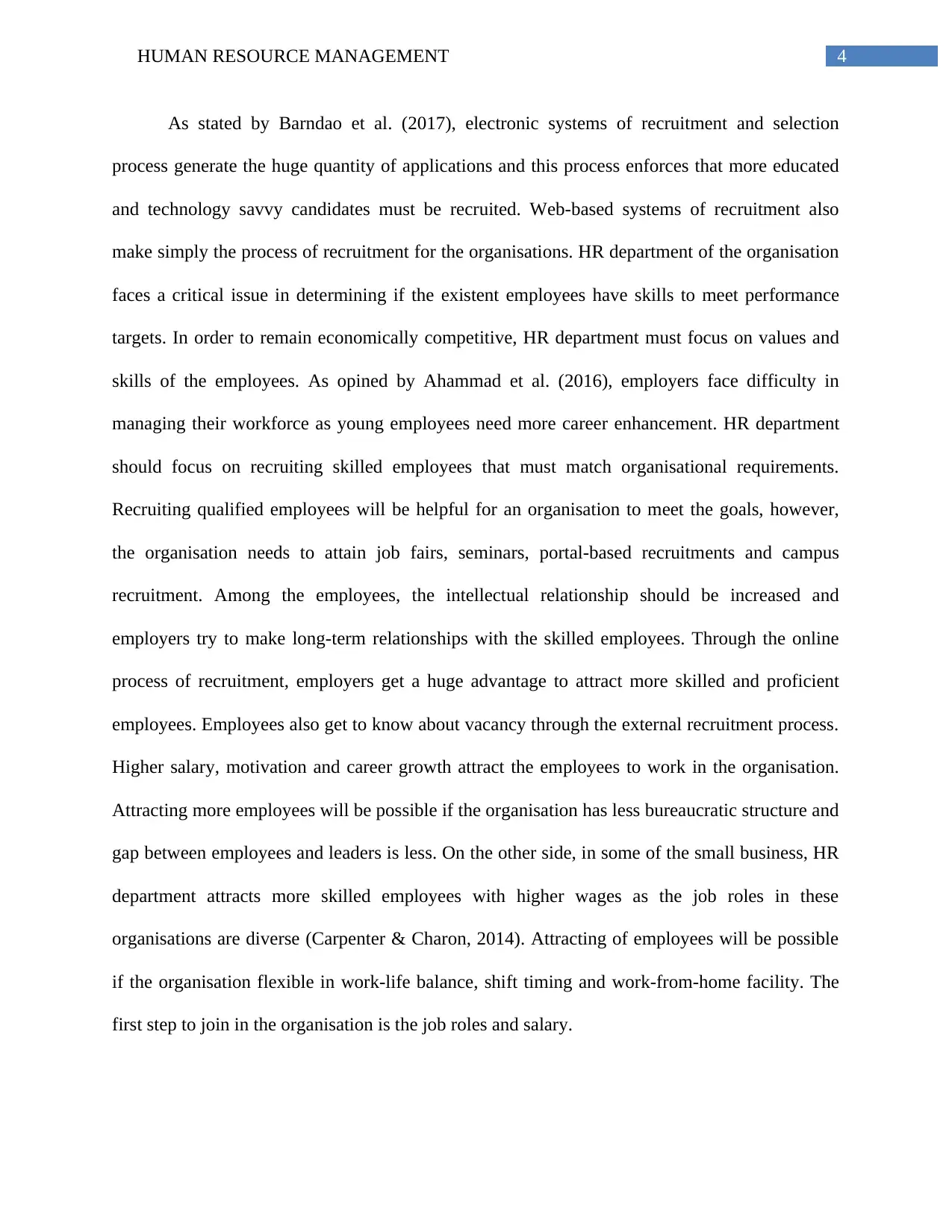
4HUMAN RESOURCE MANAGEMENT
As stated by Barndao et al. (2017), electronic systems of recruitment and selection
process generate the huge quantity of applications and this process enforces that more educated
and technology savvy candidates must be recruited. Web-based systems of recruitment also
make simply the process of recruitment for the organisations. HR department of the organisation
faces a critical issue in determining if the existent employees have skills to meet performance
targets. In order to remain economically competitive, HR department must focus on values and
skills of the employees. As opined by Ahammad et al. (2016), employers face difficulty in
managing their workforce as young employees need more career enhancement. HR department
should focus on recruiting skilled employees that must match organisational requirements.
Recruiting qualified employees will be helpful for an organisation to meet the goals, however,
the organisation needs to attain job fairs, seminars, portal-based recruitments and campus
recruitment. Among the employees, the intellectual relationship should be increased and
employers try to make long-term relationships with the skilled employees. Through the online
process of recruitment, employers get a huge advantage to attract more skilled and proficient
employees. Employees also get to know about vacancy through the external recruitment process.
Higher salary, motivation and career growth attract the employees to work in the organisation.
Attracting more employees will be possible if the organisation has less bureaucratic structure and
gap between employees and leaders is less. On the other side, in some of the small business, HR
department attracts more skilled employees with higher wages as the job roles in these
organisations are diverse (Carpenter & Charon, 2014). Attracting of employees will be possible
if the organisation flexible in work-life balance, shift timing and work-from-home facility. The
first step to join in the organisation is the job roles and salary.
As stated by Barndao et al. (2017), electronic systems of recruitment and selection
process generate the huge quantity of applications and this process enforces that more educated
and technology savvy candidates must be recruited. Web-based systems of recruitment also
make simply the process of recruitment for the organisations. HR department of the organisation
faces a critical issue in determining if the existent employees have skills to meet performance
targets. In order to remain economically competitive, HR department must focus on values and
skills of the employees. As opined by Ahammad et al. (2016), employers face difficulty in
managing their workforce as young employees need more career enhancement. HR department
should focus on recruiting skilled employees that must match organisational requirements.
Recruiting qualified employees will be helpful for an organisation to meet the goals, however,
the organisation needs to attain job fairs, seminars, portal-based recruitments and campus
recruitment. Among the employees, the intellectual relationship should be increased and
employers try to make long-term relationships with the skilled employees. Through the online
process of recruitment, employers get a huge advantage to attract more skilled and proficient
employees. Employees also get to know about vacancy through the external recruitment process.
Higher salary, motivation and career growth attract the employees to work in the organisation.
Attracting more employees will be possible if the organisation has less bureaucratic structure and
gap between employees and leaders is less. On the other side, in some of the small business, HR
department attracts more skilled employees with higher wages as the job roles in these
organisations are diverse (Carpenter & Charon, 2014). Attracting of employees will be possible
if the organisation flexible in work-life balance, shift timing and work-from-home facility. The
first step to join in the organisation is the job roles and salary.
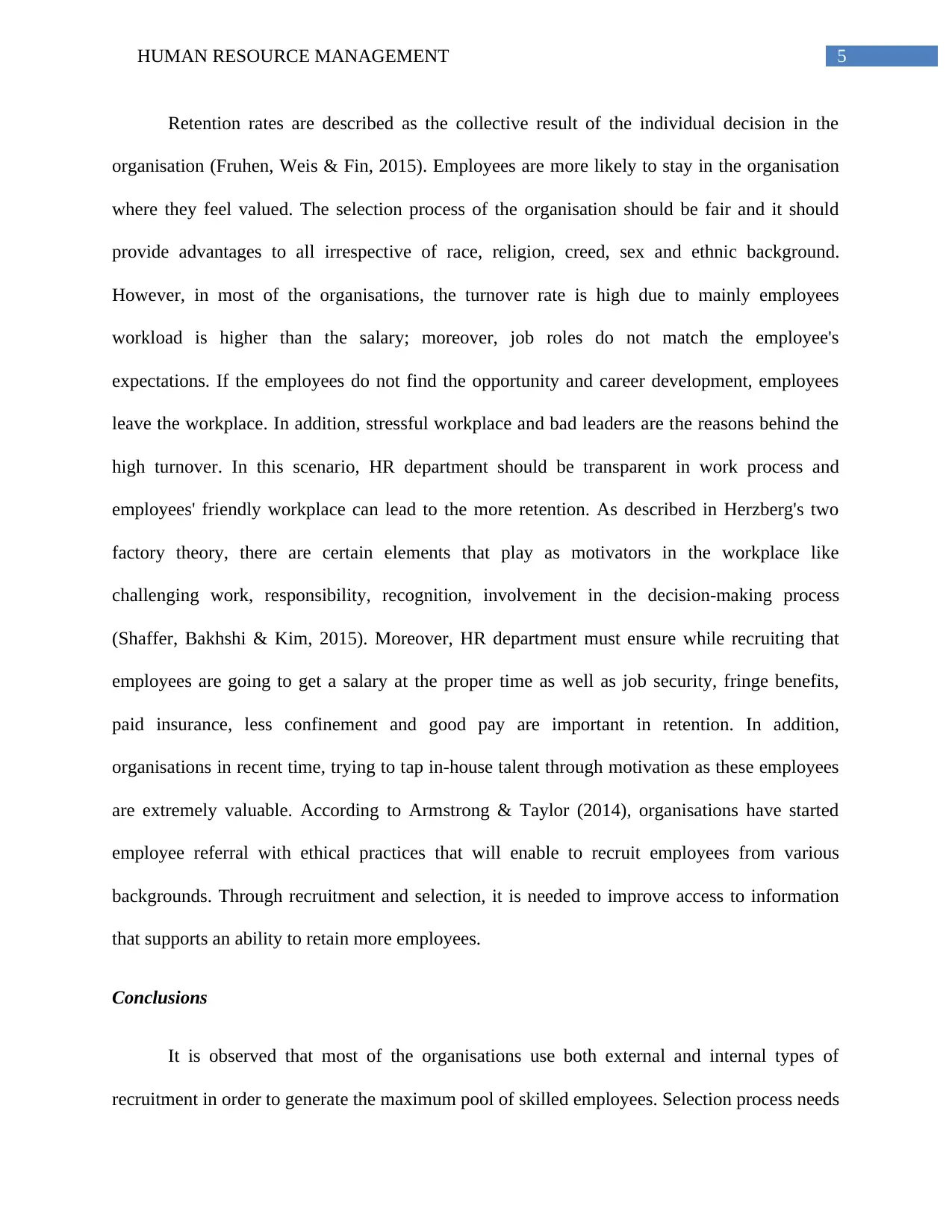
5HUMAN RESOURCE MANAGEMENT
Retention rates are described as the collective result of the individual decision in the
organisation (Fruhen, Weis & Fin, 2015). Employees are more likely to stay in the organisation
where they feel valued. The selection process of the organisation should be fair and it should
provide advantages to all irrespective of race, religion, creed, sex and ethnic background.
However, in most of the organisations, the turnover rate is high due to mainly employees
workload is higher than the salary; moreover, job roles do not match the employee's
expectations. If the employees do not find the opportunity and career development, employees
leave the workplace. In addition, stressful workplace and bad leaders are the reasons behind the
high turnover. In this scenario, HR department should be transparent in work process and
employees' friendly workplace can lead to the more retention. As described in Herzberg's two
factory theory, there are certain elements that play as motivators in the workplace like
challenging work, responsibility, recognition, involvement in the decision-making process
(Shaffer, Bakhshi & Kim, 2015). Moreover, HR department must ensure while recruiting that
employees are going to get a salary at the proper time as well as job security, fringe benefits,
paid insurance, less confinement and good pay are important in retention. In addition,
organisations in recent time, trying to tap in-house talent through motivation as these employees
are extremely valuable. According to Armstrong & Taylor (2014), organisations have started
employee referral with ethical practices that will enable to recruit employees from various
backgrounds. Through recruitment and selection, it is needed to improve access to information
that supports an ability to retain more employees.
Conclusions
It is observed that most of the organisations use both external and internal types of
recruitment in order to generate the maximum pool of skilled employees. Selection process needs
Retention rates are described as the collective result of the individual decision in the
organisation (Fruhen, Weis & Fin, 2015). Employees are more likely to stay in the organisation
where they feel valued. The selection process of the organisation should be fair and it should
provide advantages to all irrespective of race, religion, creed, sex and ethnic background.
However, in most of the organisations, the turnover rate is high due to mainly employees
workload is higher than the salary; moreover, job roles do not match the employee's
expectations. If the employees do not find the opportunity and career development, employees
leave the workplace. In addition, stressful workplace and bad leaders are the reasons behind the
high turnover. In this scenario, HR department should be transparent in work process and
employees' friendly workplace can lead to the more retention. As described in Herzberg's two
factory theory, there are certain elements that play as motivators in the workplace like
challenging work, responsibility, recognition, involvement in the decision-making process
(Shaffer, Bakhshi & Kim, 2015). Moreover, HR department must ensure while recruiting that
employees are going to get a salary at the proper time as well as job security, fringe benefits,
paid insurance, less confinement and good pay are important in retention. In addition,
organisations in recent time, trying to tap in-house talent through motivation as these employees
are extremely valuable. According to Armstrong & Taylor (2014), organisations have started
employee referral with ethical practices that will enable to recruit employees from various
backgrounds. Through recruitment and selection, it is needed to improve access to information
that supports an ability to retain more employees.
Conclusions
It is observed that most of the organisations use both external and internal types of
recruitment in order to generate the maximum pool of skilled employees. Selection process needs
⊘ This is a preview!⊘
Do you want full access?
Subscribe today to unlock all pages.

Trusted by 1+ million students worldwide
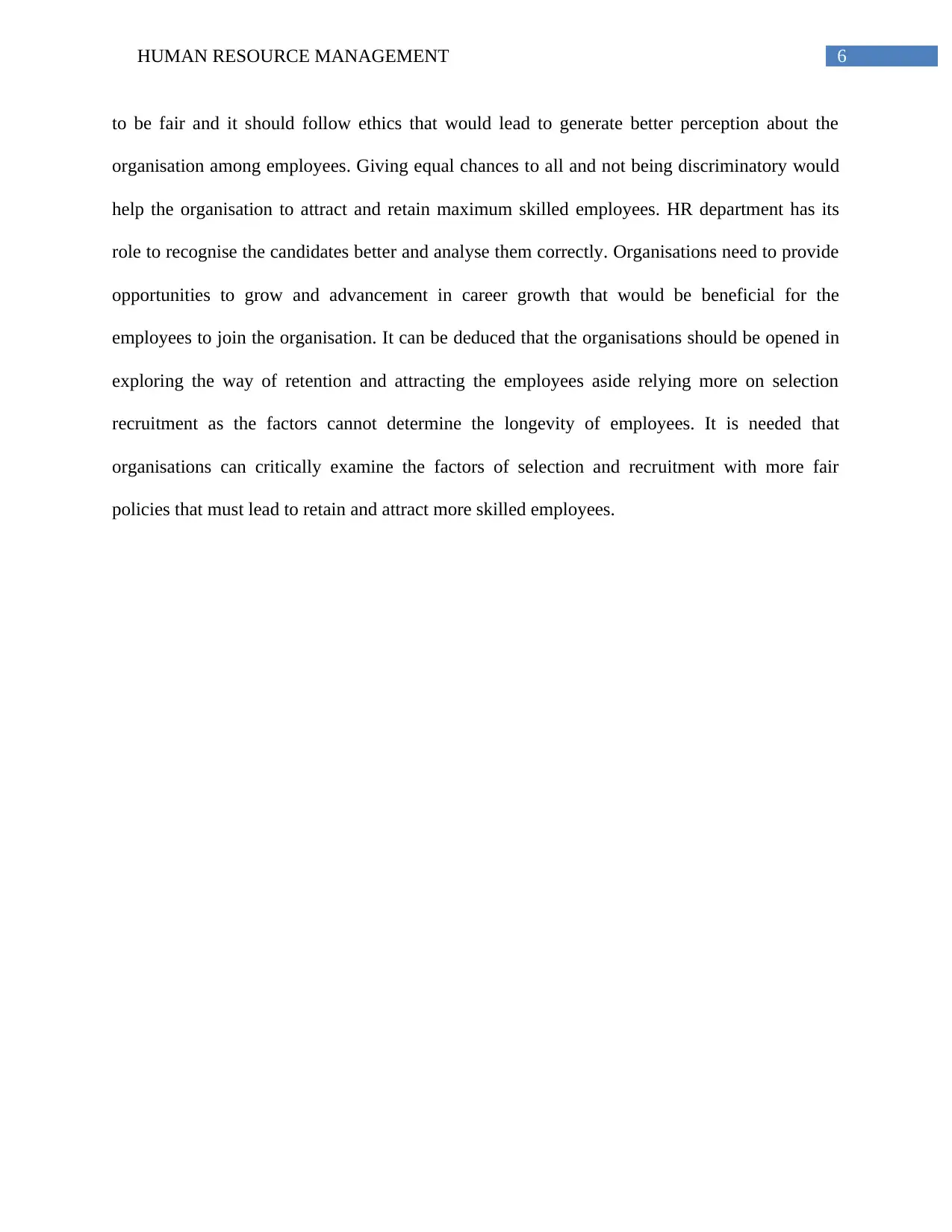
6HUMAN RESOURCE MANAGEMENT
to be fair and it should follow ethics that would lead to generate better perception about the
organisation among employees. Giving equal chances to all and not being discriminatory would
help the organisation to attract and retain maximum skilled employees. HR department has its
role to recognise the candidates better and analyse them correctly. Organisations need to provide
opportunities to grow and advancement in career growth that would be beneficial for the
employees to join the organisation. It can be deduced that the organisations should be opened in
exploring the way of retention and attracting the employees aside relying more on selection
recruitment as the factors cannot determine the longevity of employees. It is needed that
organisations can critically examine the factors of selection and recruitment with more fair
policies that must lead to retain and attract more skilled employees.
to be fair and it should follow ethics that would lead to generate better perception about the
organisation among employees. Giving equal chances to all and not being discriminatory would
help the organisation to attract and retain maximum skilled employees. HR department has its
role to recognise the candidates better and analyse them correctly. Organisations need to provide
opportunities to grow and advancement in career growth that would be beneficial for the
employees to join the organisation. It can be deduced that the organisations should be opened in
exploring the way of retention and attracting the employees aside relying more on selection
recruitment as the factors cannot determine the longevity of employees. It is needed that
organisations can critically examine the factors of selection and recruitment with more fair
policies that must lead to retain and attract more skilled employees.
Paraphrase This Document
Need a fresh take? Get an instant paraphrase of this document with our AI Paraphraser
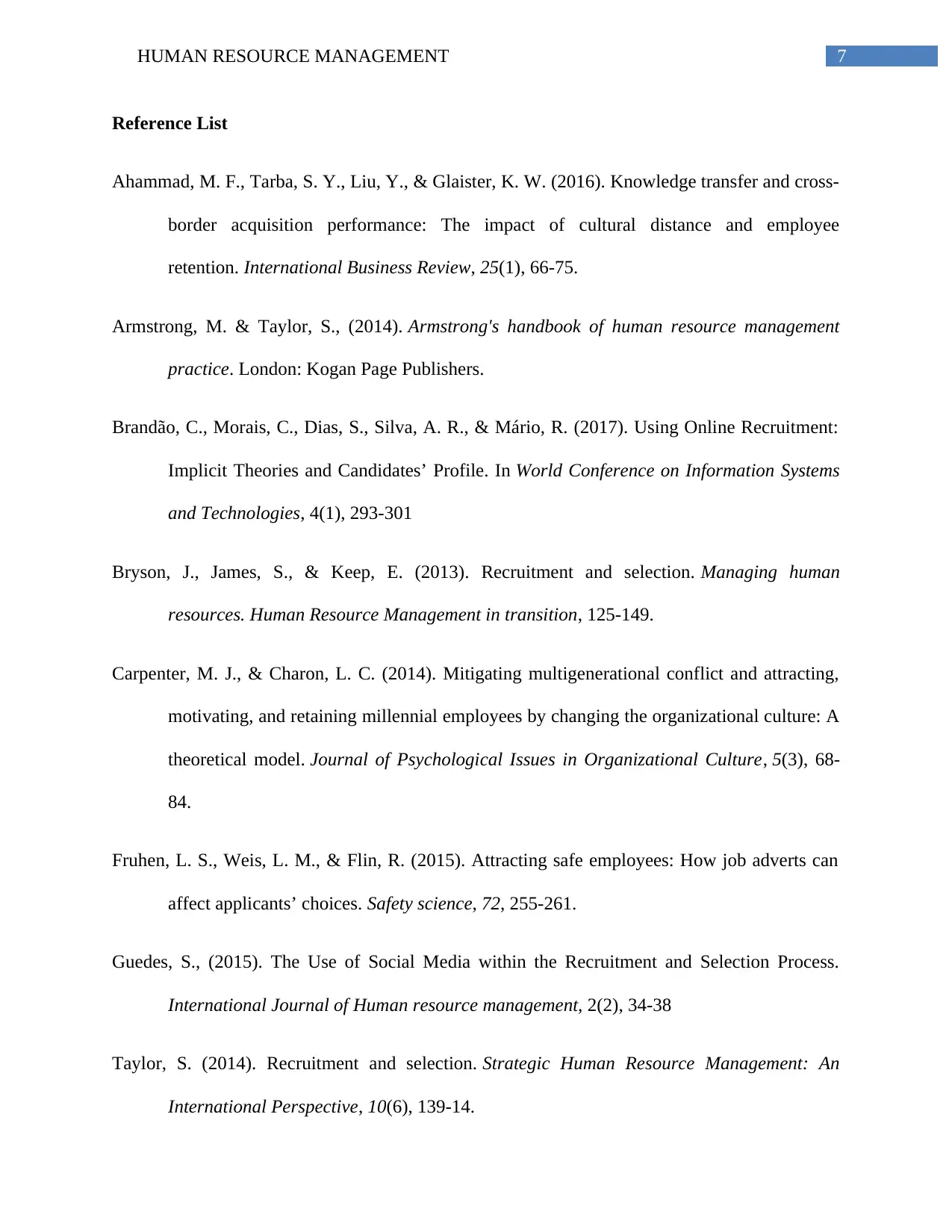
7HUMAN RESOURCE MANAGEMENT
Reference List
Ahammad, M. F., Tarba, S. Y., Liu, Y., & Glaister, K. W. (2016). Knowledge transfer and cross-
border acquisition performance: The impact of cultural distance and employee
retention. International Business Review, 25(1), 66-75.
Armstrong, M. & Taylor, S., (2014). Armstrong's handbook of human resource management
practice. London: Kogan Page Publishers.
Brandão, C., Morais, C., Dias, S., Silva, A. R., & Mário, R. (2017). Using Online Recruitment:
Implicit Theories and Candidates’ Profile. In World Conference on Information Systems
and Technologies, 4(1), 293-301
Bryson, J., James, S., & Keep, E. (2013). Recruitment and selection. Managing human
resources. Human Resource Management in transition, 125-149.
Carpenter, M. J., & Charon, L. C. (2014). Mitigating multigenerational conflict and attracting,
motivating, and retaining millennial employees by changing the organizational culture: A
theoretical model. Journal of Psychological Issues in Organizational Culture, 5(3), 68-
84.
Fruhen, L. S., Weis, L. M., & Flin, R. (2015). Attracting safe employees: How job adverts can
affect applicants’ choices. Safety science, 72, 255-261.
Guedes, S., (2015). The Use of Social Media within the Recruitment and Selection Process.
International Journal of Human resource management, 2(2), 34-38
Taylor, S. (2014). Recruitment and selection. Strategic Human Resource Management: An
International Perspective, 10(6), 139-14.
Reference List
Ahammad, M. F., Tarba, S. Y., Liu, Y., & Glaister, K. W. (2016). Knowledge transfer and cross-
border acquisition performance: The impact of cultural distance and employee
retention. International Business Review, 25(1), 66-75.
Armstrong, M. & Taylor, S., (2014). Armstrong's handbook of human resource management
practice. London: Kogan Page Publishers.
Brandão, C., Morais, C., Dias, S., Silva, A. R., & Mário, R. (2017). Using Online Recruitment:
Implicit Theories and Candidates’ Profile. In World Conference on Information Systems
and Technologies, 4(1), 293-301
Bryson, J., James, S., & Keep, E. (2013). Recruitment and selection. Managing human
resources. Human Resource Management in transition, 125-149.
Carpenter, M. J., & Charon, L. C. (2014). Mitigating multigenerational conflict and attracting,
motivating, and retaining millennial employees by changing the organizational culture: A
theoretical model. Journal of Psychological Issues in Organizational Culture, 5(3), 68-
84.
Fruhen, L. S., Weis, L. M., & Flin, R. (2015). Attracting safe employees: How job adverts can
affect applicants’ choices. Safety science, 72, 255-261.
Guedes, S., (2015). The Use of Social Media within the Recruitment and Selection Process.
International Journal of Human resource management, 2(2), 34-38
Taylor, S. (2014). Recruitment and selection. Strategic Human Resource Management: An
International Perspective, 10(6), 139-14.
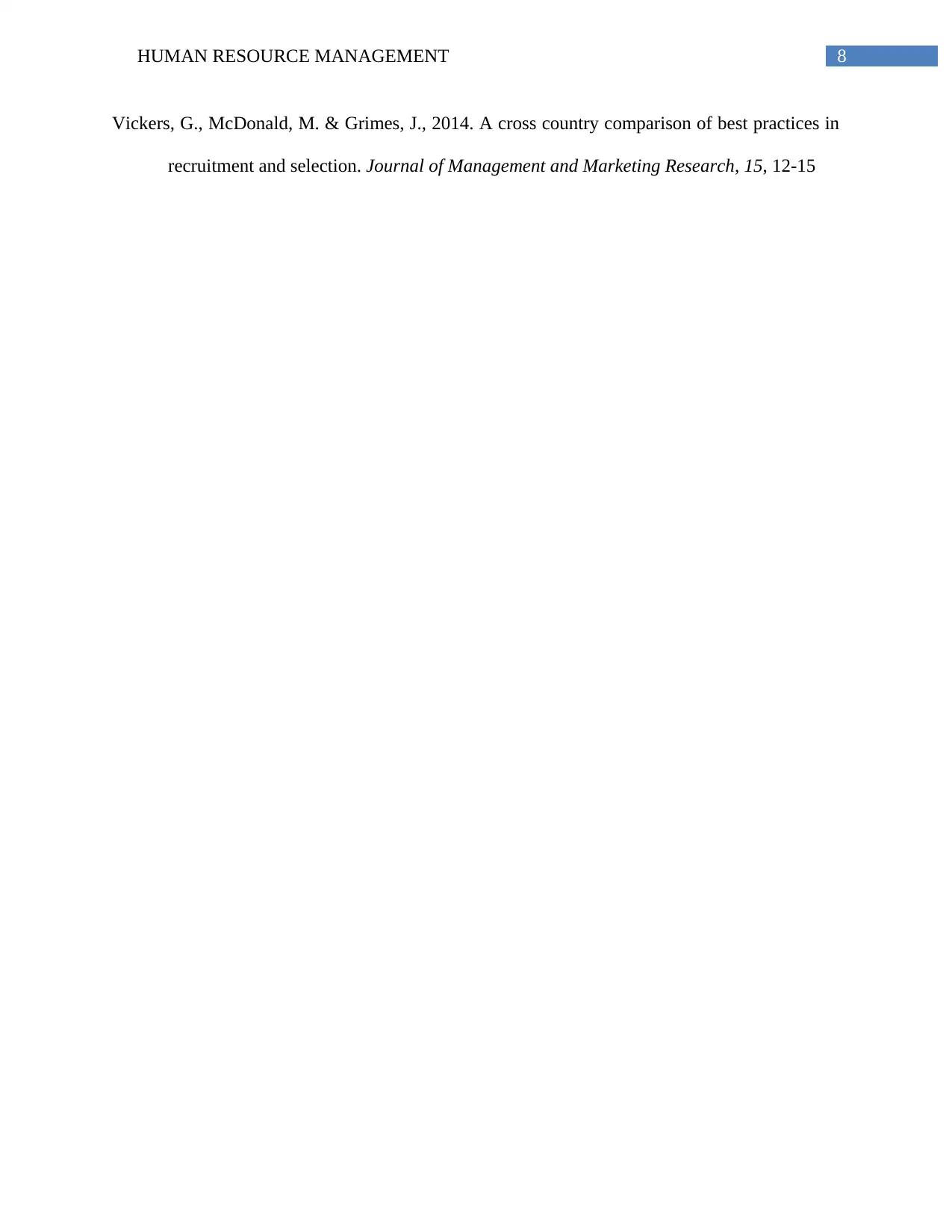
8HUMAN RESOURCE MANAGEMENT
Vickers, G., McDonald, M. & Grimes, J., 2014. A cross country comparison of best practices in
recruitment and selection. Journal of Management and Marketing Research, 15, 12-15
Vickers, G., McDonald, M. & Grimes, J., 2014. A cross country comparison of best practices in
recruitment and selection. Journal of Management and Marketing Research, 15, 12-15
⊘ This is a preview!⊘
Do you want full access?
Subscribe today to unlock all pages.

Trusted by 1+ million students worldwide
1 out of 9
Related Documents
Your All-in-One AI-Powered Toolkit for Academic Success.
+13062052269
info@desklib.com
Available 24*7 on WhatsApp / Email
![[object Object]](/_next/static/media/star-bottom.7253800d.svg)
Unlock your academic potential
Copyright © 2020–2025 A2Z Services. All Rights Reserved. Developed and managed by ZUCOL.




